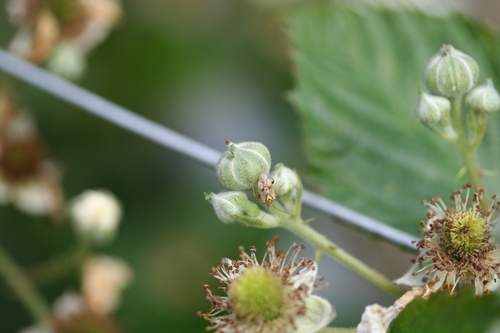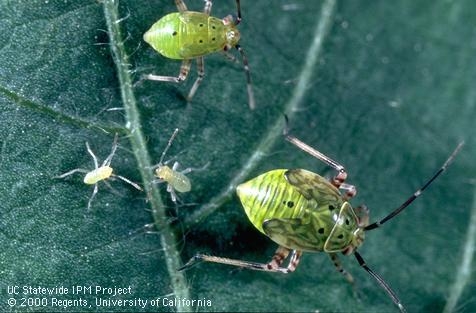Posts Tagged: lygus bug
MPede and Aza-Direct for Control of Lygus Bugs in Blackberries
As many Central Coast caneberry growers know, this summer season has seen an astonishing number of lygus bugs in blackberries. Counts of 10 to 20 lygus bugs per shake easily rival the heaviest infestations in strawberry.
However, contrary to the “catfacing” or misshapen fruit left by lygus activity in strawberry, there does not seem to be a documented type of damage from lygus in blackberry. All the same, customers have been getting tetchy about having bugs in their baskets of fruit, so it is indeed important for us as an industry to take this on.
Unfortunately, management of lygus in blackberry has proven to be just as difficult in blackberry as strawberry, perhaps even more so since there are fewer insecticides registered for use in blackberries.
Thrips incidentally occur in blackberry flowers as well and did in great numbers in this trial. Again it is not certain whether or not they cause a lot of damage. Nevertheless, thrips were also evaluated in this trial since they are a known pest in other crops and situations.
The organically registered insecticides MPede and Aza-Direct have shown promise in controlling stink bugs (same insect order as lygus bugs), so the study described below is a screen these two materials compared against a grower applied standard of Diazinon along with an untreated control.
Trial was composed of 4 24 ft x 26 ft replicated treatments in a blackberry field with significant lygus and thrips activity. MPede and Aza-Direct were applied with a motorized backpack sprayer by Brian Deeter from Gowan Company. Diazinon was applied at the label rate by the grower in an adjacent block, so while not part of the experimental design, it did provide reasonably strong information in comparison to the three other treatments.
My research assistant and I did the evaluations which consisted of shaking 3 feet of flowering blackberry hedgerow into a five gallon bucket for the lygus and agitating three mature flowers individually onto a white sheet of paper and counting the expulsed thrips there. Dates of evaluation were August 11 (pre-application), August 15 and August 19 (one week post application).
As the reader can see from the chart below, beyond Diazinon there is little effect on field populations of lygus or thrips from either MPede or Aza-Direct. Furthermore, the lack of thorough control of lygus and thrips by Diazinon, long regarded as one of the most powerful pesticides available to blackberry growers, is unsettling.
|
Character Rated |
lygus |
thrips |
lygus |
thrips |
lygus |
thrips |
|||||||
|
Rating Date |
Pre-app |
Pre-app |
8/15/2011 |
8/15/2011 |
8/19/2011 |
8/19/2011 |
|||||||
|
1 |
MPede + Aza-Direct |
35.75 |
a |
84.50 |
a |
31.50 |
a |
72.00 |
ab |
16.50 |
a |
54.75 |
ab |
|
2 |
MPede |
28.75 |
a |
56.50 |
a |
37.25 |
a |
120.25 |
a |
19.50 |
a |
67.75 |
a |
|
3 |
UTC |
36.00 |
a |
73.50 |
a |
34.75 |
a |
104.75 |
a |
15.50 |
a |
52.00 |
ab |
|
4 |
Diazinon |
22.50 |
a |
38.25 |
a |
11.25 |
b |
34.50 |
b |
11.50 |
a |
24.25 |
b |
Means followed by same letter do not significantly differ (P=.05, Student-Newman-Keuls)
Mean comparisons performed only when AOV Treatment P(F) is significant at mean comparison OSL.
Finally, it will be worth my while to return to this field to evaluate the effect, if any, this pest load is having on fruit development. As already mentioned above, beyond the contamination of harvested fruit, thrips and lygus damage to blackberry has not yet been well defined.
There are a number of pesticides mentioned for management of lygus and thrips in this article. Before using any of these products, check with your local Agricultural Commissioner's Office and consult product labels for current status of product registration, restrictions, and use information.

Lygus bug adult on unopened blackberry flower
Lygus in Blackberries?
Starting Friday and over the weekend, a number of area blackberry growers have reported high numbers of lygus bugs in their fields. I checked on one field this morning, and indeed the level of infestation is astonishing. Somewhere in the area of ten early stage nymphs can fall out from a few shakes at a single spot at any number of points all across the field. This is without precedent in any type of berry and merits some thought and discussion.
The field that was viewed this morning was in full harvest with a lot of fruit in the yet green to pink stage. Primocane was still growing vegetatively with no flowering. I do not think lygus presents any harm to the quality of the fruit or the vegetative plant, other than as an incidental contaminant in the baskets of harvested fruit, much along the lines of what we have recently seen with stinkbugs. Lygus bug feeding damages the flower and developing fruit, so once the druplets have made and the fruit has formed, these bugs will no longer be able to harm it. Since the field examined today has next to no flowers, the nymphs must be feeding on sap from the newly developing vegetative tissue. Whether this causes harm to the plants remains to be seen.
Beyond the contamination of harvested cited above, the possibility that this colossal lygus population shifts over to later bearing varieties which are entering into flowering would give some reason for concern.
Fortunately, blackberry growers have several options available to them to control these pests. One of the best combinations we found from our work in managing lygus in strawberries has been a pyrethroid + neonicotinoid applied when the lygus are very small as they are now. Always bear in mind that this powerful combination of pesticides will weigh heavily on beneficials. Additionally, the neonicotinoids registered in blackberries present some issues with maximum residue limits (MRL's) to fruit exported to Canada.
Organic growers have few options short of border weed removal and vacuuming available to them unfortunately.
There are pesticides mentioned for management of lygus bugs in this article. Before using any of these products, check with your local Agricultural Commissioner's Office and consult product labels for current status of product registration, restrictions, and use information.

Lygus nymphs. Note the five spots on the back of the larger nymph. The smaller nymphs, for example the two on left, would be very easy for the pest manager to handle..

